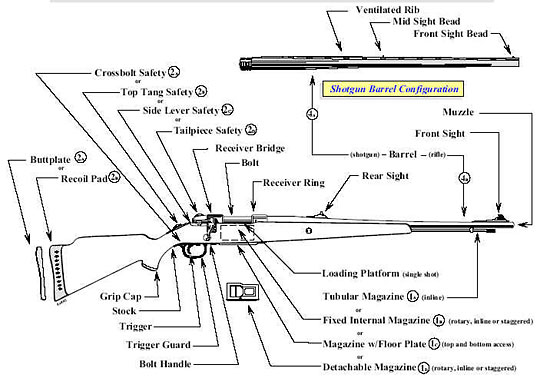About the Submarine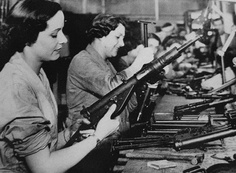
World War One, The Submarine
By the eve of World War I all of the major navies included submarines in their fleets, but these craft were relatively small, were considered of questionable military value, and generally were intended for coastal operations. The most significant exception to the concept of coastal activity was the German Deutschland class of merchant U-boats, each 315 feet long with two large cargo compartments. These submarines could carry 700 tons of cargo at 12- to 13-knot speeds on the surface and at seven knots submerged. The Deutschland itself became the U-155 when fitted with torpedo tubes and deck guns, and, with seven similar submarines, it served in a combat role during the latter stages of the war. In comparison, the "standard" submarine of World War I measured slightly over 200 feet in length and displaced less than 1,000 tons on the surface. The prewar submarines generally had been armed with self-propelled torpedoes for attacking enemy ships. During the war submarines also were fitted with deck guns. This permitted them to approach enemy merchant ships on the surface and signal them to stop for searching (an early war policy) and later to sink small or unarmed ships that did not warrant expenditure of torpedoes. Most war-built submarines had one and sometimes two guns of about three- or four-inch caliber; however, several later German submarines carried 150-millimetre guns (including the Deutschland class in military configuration). An important armament variation was the submarine modified to lay mines during covert missions off an enemy's harbors. The Germans constructed several specialized submarines with vertical mine tubes through their hulls; some U-boats carried 48 mines in addition to their torpedoes. Also noteworthy was the development, during the war, of the concept of an antisubmarine submarine. British submarines sank 17 German U-boats during the conflict; the early submarine-versus-submarine successes led to British development of the R-class submarine intended specifically for this role. These were relatively small craft, 163 feet long and displacing 410 tons on the surface, with only one propeller (most contemporary submarines had two). Diesel engines could drive them at nine knots on the surface, but once submerged; large batteries permitted their electric motors to drive them underwater at the high speed of 15 knots for two hours. (Ten knots was a common speed for submerged submarines until after World War II.) Thus, they were both maneuverable and fast. Advanced underwater listening equipment (asdic, or sonar) was installed, and six forward torpedo tubes made them potent weapons. Although these submarines appeared too late to have any actual effect on the war, they pioneered a new concept in the development of the submarine. All World War I-era submarines were propelled by diesels on the surface and by electric motors submerged, except for the British Swordfish and K class. These submarines, intended to operate as scouts for surface warships, required the high speeds then available only from steam turbines. The K-boats steamed at 23.5 knots on the surface, while electric motors gave them a 10-knot submerged speed. World History Project 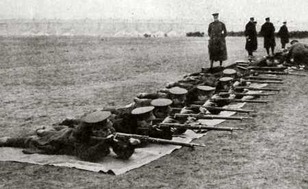
Submarine Operators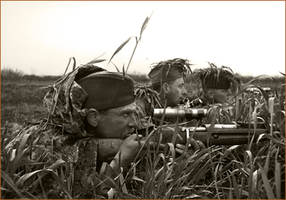
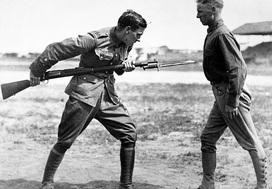
Inefficiencies Lead to Improvements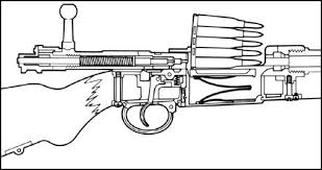

|
Tool BoxVocabulary to Knowammunition: the bullets or shells shot from a weapon
bayonet: a large jagged knife that attached to the end of a rifle barrel in order to turn the rifle into a thrusting weapon bolt action: when a sliding rod or bar shoves a cartridge into the firing chamber of a weapon bore: the hollow part inside a gun barrel or other tube clip: a device that is used to store multiple rounds of ammunition together as a unit to be inserted into a magazine defensive battle: a defense; when a nation or group of nations attempt to protect their territory from attack or invasion defensive weapon: a weapon - usually having a short range - made or adapted for protecting a person by causing serious injury or death to the attacker front line: the place where fighting is done face to face in a battle inefficiencies: the inability to do something in the best way possible; when something valuable (ex. time, money, lives, ammunition) is wasted in the process of doing something infantry: Infantry is the branch of an army that fights on foot — soldiers specifically trained to engage, fight, and defeat the enemy in face-to-face combat; and thus bear the brunt of warfare, and suffer the greatest number of casualties magazine: the cylinder part of a weapon that holds a clip of ammunition; used to speed up the process of loading and reloading a weapon because several rounds of ammunition can be loaded at once, rather than one round being loaded at a time manufacturing: producing a large amount of one product in a factory using machines, an assembly line, and division of labor offensive battle: an invasion; when a nation or group of nations initiate an attack with the intent of taking over territory from the nation they are attacking offensive weapon: a weapon - usually having a long range - made or adapted for attacking another person and causing serious injury or death range: the distance something has covered or reached rate of fire: the amount of bullets or ammunition a weapons can fire without having to reload rifle: a gun, esp. one fired from shoulder level, having a long spirally grooved barrel intended to make a bullet spin and thereby have greater accuracy over a long distance. sniper: a gunman who's job is to pick of targets on the opposing side in a battle because he is an expert at shooting accurately over a long range standard issue: the basic supplies given to everyone in the armed forces when they become a soldier |
